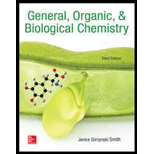
(a)
Interpretation:
The name of S2- ion should be given.
Concept Introduction:
In nomenclature of cations, the word "ion" is added after the name of a metal cation. When metal forms two different cations, either the charge is indicated by Roman numeral in parentheses after the name of the cation or the suffix "-ous" is used for cations with lesser charge and suffix "-ic" is used for the cation with higher charge. These suffixes are added to the Latin name of the element. Anions are named by replacing the ending of the element by the suffix "-ide".
(b)
Interpretation:
The name of Cu+ ion should be given.
Concept Introduction:
In nomenclature of cations, the word "ion" is added after the name of a metal cation. When metal forms two different cations, either the charge is indicated by Roman numeral in parentheses after the name of the cation or the suffix "-ous" is used for cations with lesser charge and suffix "-ic" is used for the cation with higher charge. These suffixes are added to the Latin name of the element. Anions are named by replacing the ending of the element by the suffix "-ide".
(c)
Interpretation:
The name of Cs+ ion should be given.
Concept Introduction:
In nomenclature of cations, the word "ion" is added after the name of a metal cation. When metal forms two different cations, either the charge is indicated by Roman numeral in parentheses after the name of the cation or the suffix "-ous" is used for cations with lesser charge and suffix "-ic" is used for the cation with higher charge. These suffixes are added to the Latin name of the element. Anions are named by replacing the ending of the element by the suffix "-ide".
(d)
Interpretation:
The name of Al3+ ion should be given.
Concept Introduction:
In nomenclature of cations, the word "ion" is added after the name of a metal cation. When metal forms two different cations, either the charge is indicated by Roman numeral in parentheses after the name of the cation or the suffix "-ous" is used for cations with lesser charge and suffix "-ic" is used for the cation with higher charge. These suffixes are added to the Latin name of the element. Anions are named by replacing the ending of the element by the suffix "-ide".
(e)
Interpretation:
The name of Sn4+ ion should be given.
Concept Introduction:
In nomenclature of cations, the word "ion" is added after the name of a metal cation. When metal forms two different cations, either the charge is indicated by Roman numeral in parentheses after the name of the cation or the suffix "-ous" is used for cations with lesser charge and suffix "-ic" is used for the cation with higher charge. These suffixes are added to the Latin name of the element. Anions are named by replacing the ending of the element by the suffix "-ide".
Want to see the full answer?
Check out a sample textbook solution
Chapter 3 Solutions
General, Organic, & Biological Chemistry
- Write the formula of (a) manganese(III) sulfide. (b) iron(II) cyanide. (c) potassium sulfide. (d) mercury(II) chloride.arrow_forwardIn each box, write the chemical formula of the compound formed by the cation at the head of the column and the anion at the left of the row, and then write the name of the compound. Refer only to a clean periodic table when completing this exercise. Ions Na Hg2 NH4 Pb2 Mg2 Fe3 Cu2 OH- BrO- CO32- ClO32- HSO4- Br- PO43- IO4- S2-arrow_forwardName each of the following binary ionic compounds. a. AuCl b. KCl c. AgCl d. CuCl2arrow_forward
- 3-45 Which formulas are not correct? For each that is not correct, write the correct formula. (a) Ammonium phosphate; (NH4 )2PO4 (b) Barium carbonate; Ba2CO3 (c) Aluminum sulfide; Al2S3 (d) Magnesium sulfide; MgSarrow_forwardWrite formulas for the following compounds, all of which contain polyatomic ions. a. Aluminum nitrate b. Iron(III) sulfate c. Calcium cyanide d. Lead(IV) hydroxidearrow_forward
 Introductory Chemistry: An Active Learning Approa...ChemistryISBN:9781305079250Author:Mark S. Cracolice, Ed PetersPublisher:Cengage Learning
Introductory Chemistry: An Active Learning Approa...ChemistryISBN:9781305079250Author:Mark S. Cracolice, Ed PetersPublisher:Cengage Learning Chemistry: The Molecular ScienceChemistryISBN:9781285199047Author:John W. Moore, Conrad L. StanitskiPublisher:Cengage Learning
Chemistry: The Molecular ScienceChemistryISBN:9781285199047Author:John W. Moore, Conrad L. StanitskiPublisher:Cengage Learning Chemistry: Principles and PracticeChemistryISBN:9780534420123Author:Daniel L. Reger, Scott R. Goode, David W. Ball, Edward MercerPublisher:Cengage Learning
Chemistry: Principles and PracticeChemistryISBN:9780534420123Author:Daniel L. Reger, Scott R. Goode, David W. Ball, Edward MercerPublisher:Cengage Learning General, Organic, and Biological ChemistryChemistryISBN:9781285853918Author:H. Stephen StokerPublisher:Cengage Learning
General, Organic, and Biological ChemistryChemistryISBN:9781285853918Author:H. Stephen StokerPublisher:Cengage Learning General Chemistry - Standalone book (MindTap Cour...ChemistryISBN:9781305580343Author:Steven D. Gammon, Ebbing, Darrell Ebbing, Steven D., Darrell; Gammon, Darrell Ebbing; Steven D. Gammon, Darrell D.; Gammon, Ebbing; Steven D. Gammon; DarrellPublisher:Cengage LearningChemistry: Matter and ChangeChemistryISBN:9780078746376Author:Dinah Zike, Laurel Dingrando, Nicholas Hainen, Cheryl WistromPublisher:Glencoe/McGraw-Hill School Pub Co
General Chemistry - Standalone book (MindTap Cour...ChemistryISBN:9781305580343Author:Steven D. Gammon, Ebbing, Darrell Ebbing, Steven D., Darrell; Gammon, Darrell Ebbing; Steven D. Gammon, Darrell D.; Gammon, Ebbing; Steven D. Gammon; DarrellPublisher:Cengage LearningChemistry: Matter and ChangeChemistryISBN:9780078746376Author:Dinah Zike, Laurel Dingrando, Nicholas Hainen, Cheryl WistromPublisher:Glencoe/McGraw-Hill School Pub Co





